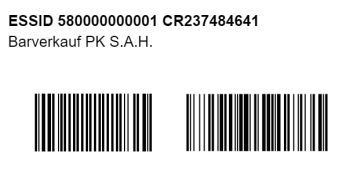Difference between revisions of "ES/S Identity Prefix"
(→Customizability) |
(→General) |
||
| Line 3: | Line 3: | ||
[[File:Essb_58_example.png|350px|thumb|A common view of prefixes are on printable labels]] | [[File:Essb_58_example.png|350px|thumb|A common view of prefixes are on printable labels]] | ||
| − | All ES/S Compatible Systems, but especially the ones used in complex enterprise applications make use of prefixed identities. This is used to clarify and allocate the identity space a company uses internally. The idea behind is to uniquely allocate prefixes to a specific dataset type or enumeration, that for example, can be a customer, a project or a task. | + | All ES/S Compatible Systems, but especially the ones used in complex enterprise applications make use of prefixed identities. This is used to clarify and allocate the identity space a company uses internally. The idea behind is to uniquely allocate prefixes to a specific dataset type or enumeration, that for example, can be a customer, a project or a task. |
| + | |||
| + | Most systems used alongside database systems use non prefixed auto-incrementing counters, that do not reset upon entry deletion. The ES/S Systems differ somewhat that all available space is used at any time. This behaviour maximizes disburse of storage expenses and merchantability of the complete organization. The space filling can be deactivated and is linked closely with checksum creation to ensure no confusions are made during data maintenance. | ||
=== Benefits === | === Benefits === | ||
Revision as of 04:14, 28 April 2023
Contents
General
All ES/S Compatible Systems, but especially the ones used in complex enterprise applications make use of prefixed identities. This is used to clarify and allocate the identity space a company uses internally. The idea behind is to uniquely allocate prefixes to a specific dataset type or enumeration, that for example, can be a customer, a project or a task.
Most systems used alongside database systems use non prefixed auto-incrementing counters, that do not reset upon entry deletion. The ES/S Systems differ somewhat that all available space is used at any time. This behaviour maximizes disburse of storage expenses and merchantability of the complete organization. The space filling can be deactivated and is linked closely with checksum creation to ensure no confusions are made during data maintenance.
Benefits
The benefits of using a prefixed identity scheme are obviously achieving direct adressability both electronically and manually. A lone datasets provides the exact usage type of following identity suffixes and can be addressed without further information on any process, no matter if on paper or transmitted digitally.
Format
Due to compatibility with legacy systems and legacy hardware, the vast majority of resources for enterprise applications uses digits only. Some identites can include alphabetic characters, or multidimensional prefixing (ES/S Identity Chain). The products that solely rely on in-place programming and integrated scripting environments, like ES/S-A take advantage of alphabetic prefixes.
List of common prefixes
Extensible Services / Server
| Prefix | Type | Description |
|---|---|---|
| 1 | User Identity | Used for System Identities (most commonly users or robots) |
| 7 | System Identity Approval Permission | This identity is used pan-system wide exclusively to control programmed permissions |
Extensible Services / Server for Automation
| Prefix | Type | Description |
|---|---|---|
| CS/CSES | Complex Service | Used to identify complex typed system assets (CTSA) |
| AS/ASES | Primitive Service | Used to identify primitive typed system assets (PTSA) |
Extensible Services / Server for Business
| Prefix | Type | Description |
|---|---|---|
| 57 | Customer (ESSB.DefaultCustomer) | A Customer Data set, commonly used to identify a companies customers |
| 58 | Order (ESSB.PrefactureOrder) | A Prefactured Order, for example a online shop order, that have been paid for while before or while ordering |
| 59 | Order (ESSB.PostfactureOrder) | A Postfactured Order, for example a bill for services or delivered goods, that have sent out before payments have occured |
| 72 | Project (ESSB.Project) | A Project, for example a collection of tasks or roadmaps to achieve orders |
Extensible Services / Server for Web Services
| Prefix | Type | Description |
|---|---|---|
| K | Network Process Fingerprint | A Network Process Fingerprint is used to identitfy a exact resource copy that was sent to a client device over a network like the internet. |
Pan-Organizational Use
Between branches or accros different legal entities, all identities can be chained. Secondly, any ES/S-Compatible identity has a unique checksum (Starting with CR) that can verify if a identity really belongs to a specific organization. These checksums are calculated from the organizational identifier key.
Customizability
Most distributions allow for extension or forking of data types. This mechanisms include addressing of unallocated prefixes. The prefix length is not limited, however included identities (compatibility layer) are generally 2-digits, while recent innovations use variable length or unsectioned prefixing.
